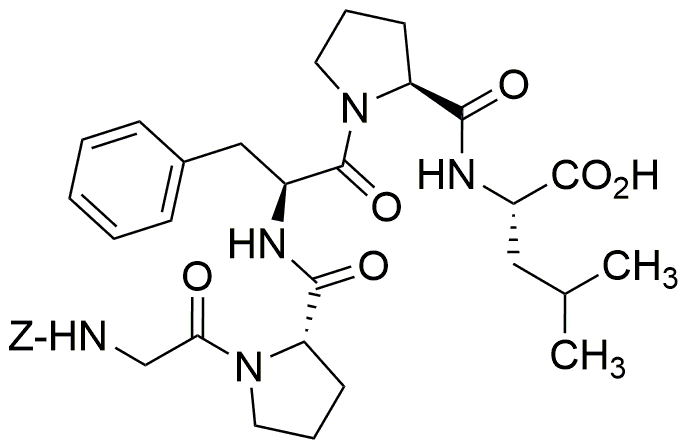Z-Gly-Pro-Phe-Pro-Leu-OH is widely utilized in research focused on:
- Peptide Synthesis: This compound serves as a key building block in the synthesis of peptides, which are essential in drug development and biochemistry. Its specific sequence can enhance the stability and efficacy of therapeutic peptides.
- Drug Development: Researchers leverage this compound in the design of novel pharmaceuticals, particularly in targeting specific biological pathways. Its unique structure allows for tailored interactions with biological receptors.
- Biotechnology: In the field of biotechnology, it is used to create specialized proteins and enzymes that can improve industrial processes, such as in the production of biofuels or bioplastics.
- Cosmetic Formulations: The compound is also explored in cosmetic science for its potential to enhance skin penetration and improve the delivery of active ingredients in skincare products.
- Research on Protein Interactions: It plays a role in studies investigating protein-protein interactions, aiding scientists in understanding cellular mechanisms and developing targeted therapies for various diseases.
General Information
Properties
Safety and Regulations
Applications
Z-Gly-Pro-Phe-Pro-Leu-OH is widely utilized in research focused on:
- Peptide Synthesis: This compound serves as a key building block in the synthesis of peptides, which are essential in drug development and biochemistry. Its specific sequence can enhance the stability and efficacy of therapeutic peptides.
- Drug Development: Researchers leverage this compound in the design of novel pharmaceuticals, particularly in targeting specific biological pathways. Its unique structure allows for tailored interactions with biological receptors.
- Biotechnology: In the field of biotechnology, it is used to create specialized proteins and enzymes that can improve industrial processes, such as in the production of biofuels or bioplastics.
- Cosmetic Formulations: The compound is also explored in cosmetic science for its potential to enhance skin penetration and improve the delivery of active ingredients in skincare products.
- Research on Protein Interactions: It plays a role in studies investigating protein-protein interactions, aiding scientists in understanding cellular mechanisms and developing targeted therapies for various diseases.
Documents
Safety Data Sheets (SDS)
The SDS provides comprehensive safety information on handling, storage, and disposal of the product.
Product Specification (PS)
The PS provides a comprehensive breakdown of the product’s properties, including chemical composition, physical state, purity, and storage requirements. It also details acceptable quality ranges and the product's intended applications.
Certificates of Analysis (COA)
Search for Certificates of Analysis (COA) by entering the products Lot Number. Lot and Batch Numbers can be found on a product’s label following the words ‘Lot’ or ‘Batch’.
*Catalog Number
*Lot Number
Certificates Of Origin (COO)
This COO confirms the country where the product was manufactured, and also details the materials and components used in it and whether it is derived from natural, synthetic, or other specific sources. This certificate may be required for customs, trade, and regulatory compliance.
*Catalog Number
*Lot Number
Safety Data Sheets (SDS)
The SDS provides comprehensive safety information on handling, storage, and disposal of the product.
DownloadProduct Specification (PS)
The PS provides a comprehensive breakdown of the product’s properties, including chemical composition, physical state, purity, and storage requirements. It also details acceptable quality ranges and the product's intended applications.
DownloadCertificates of Analysis (COA)
Search for Certificates of Analysis (COA) by entering the products Lot Number. Lot and Batch Numbers can be found on a product’s label following the words ‘Lot’ or ‘Batch’.
*Catalog Number
*Lot Number
Certificates Of Origin (COO)
This COO confirms the country where the product was manufactured, and also details the materials and components used in it and whether it is derived from natural, synthetic, or other specific sources. This certificate may be required for customs, trade, and regulatory compliance.


